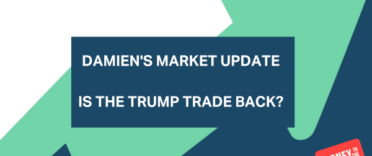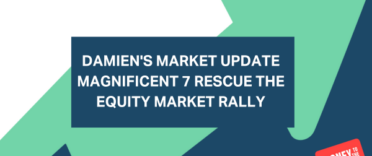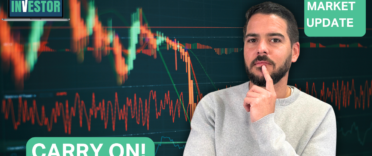Welcome to the latest episode of my monthly YouTube show where I discuss what is happening in investment markets and what to look out for. Today I explain why investors need to keep a close eye on commodity prices.
Each show lasts between 5-10 minutes and is aimed at DIY investors (including novices) seeking contemporary analysis to help them understand how investment markets work.
Subscribe to my YouTube channel to receive my weekly analysis of investment markets or alternatively, you can listen via my weekly Midweek Markets podcast below.
Damien's Market Updates monthly podcast
Other ways to watch, listen and subscribe
You can listen to other episodes and subscribe to the show by searching 'Money to the Masses' on Spotify or by using the following links:
Abridged transcript - Damien's Market Update - July 2022
Last month’s show was titled “Looking to central banks for direction” which was apt given that June became characterised by intense volatility mostly centred around the monetary policy announcements from major central banks most notably that of the US Federal Reserve.
But it was perhaps the European Central Bank (ECB) that surprised investors the most since my last show.. Ahead of the ECB meeting on 9th June investors anticipated a continuation of the central bank’s more dovish approach when compared to both the Federal Reserve and the Bank of England. However, this time around, President Christine Legarde turned surprisingly hawkish, confirming the ECB’s intentions to increase interest rates for the eurozone by 0.25% in July, followed by a potentially larger hike in September if economic indicators support it. The shock led to a sell-off in European equities with the Stoxx 600 tumbling, ultimately finishing June down by almost 9%.
But some of the more worrying moves occurred in bonds markets, as borrowing costs for the more heavily indebted eurozone countries hit an 8-year high. Spreads between core and peripheral countries widened, with the Italian-German spread - the standard indicator of stability in the region - hitting a level not seen since April 2020. This threatened to send the eurozone into another European debt crisis, as we saw in 2010. Who would have predicted that at the start of June?
The situation escalated so quickly that the ECB was forced to call an emergency meeting to deal with the impact of its decision to start withdrawing monetary support. The result of the meeting - an as-yet unfleshed out bond-buying plan - resulted in a rally in bond markets, putting yields back on a downward trajectory. But until more details emerge there remains a risk that markets could fly into a panic once again.
But by mid-June markets were in turmoil again ahead of interest rate decisions from the Federal Reserve and the Bank of England on 15th and 16th June, respectively. The former opted to hike rates by 0.75%, while the Bank of England, put its base rate up by 0.25% to 1.25%, its fifth increase in a row, with inflation reaching 9.1%.
But the final weeks of June could well be remembered as the point when the market narrative pivoted dramatically, setting up a potential change in market direction for the second half of 2022. If you recall, at the start of June stagflation was the buzzword in markets, i.e. slowing growth alongside inflation. And at the time I explained that it was the interaction between market fear of inflation vs fear over a lack of economic growth that would likely change the market trends we were seeing at the time. Back then the fear of inflation was hurting bonds more than the fear of slowing growth could support them. I reasoned that as soon as investors began thinking inflation had peaked then don’t be surprised if we saw a rally in bonds as economic growth fears took centre stage.
Towards the end of June the threat of inflation was usurped by the rising risk of recession. This was compunded when the Fed’s Chair, Jerome Powell explicitly stated that the move to raise interest rates to tackle inflation could cause a recession. The fear of recession gripped markets and bond markets in particular. The 10 year US treasury yield fell from 3.5% to 3.06% in a matter of days. And since then we’ve since the 10 year US treasury yield fall below 3%. Moves that have been replicated in bond markets outside of the US as well, as investors began hedging against the possibility of a recession.
For equities, though, it brought about a bleak end to a challenging month, with the S&P 500 ending June almost 8.5% down on the previous month. The Nasdaq Composite, which has a higher weighting to tech stocks, also fell by a similar amount across the month. The continued slump in equity markets means that June brought to a close one of the worst starts to a year, from an investment perspective, in more than 50 years. But not only that but a typical 60% equity / 40% bond portfolio was down around 11% in the first half of 2022, as bonds have slumped alongside equities
Going into June commodities had been one of the best performing asset classes so far in 2022 but the surge in recession fears saw most commodities enter into bear markets during the month. The slump in commodities hasn't been grabbing headlines but maybe that isn't surprising given that despite the 20% slump in the price of oil during a two-week period in June the price was still up over 40% come the end of the month.
But it was the strong price moves in copper that gained my attention. I dedicated part of Sunday’s podcast show to explaining the importance of copper as an economic indicator. Suffice to say that Dr Copper is clearly concerned about the health of the global economy and the increasing likelihood of a recession.
One bright spot in equity markets were Chinese equities as covid restrictions were eased and monetary policy was loosened in China, while Chinese tech stocks staged a recovery thanks to fewer interventions from the government. It’s certainly something to watch going into July.
Meanwhile the pound has fallen to a 2 year low below $1.19 against the dollar, not helped by political events which resulted in Borish Johnson resigning. Will the downward pressure continue? It is also important to keep an eye on bond yields for signs that the bond bear market is finally over, if recession fears take hold. Don’t just look for a fall in yields, also look for signs of the yield curve inverting (i.e the yield on short term government debt being higher than long term equivalents). We are already seeing signs of that in the US. Does that mean that we will now see more defensive equity sectors, such as health care, utilites and consumer staples outperform more cyclical sectors such as energy that have been the best performers this year.
And what of the ECB’s rescue plan to effectively save the euro? Will central banks carry on tightening monetary policy to comabt inflation and cause a global recession. Or has inflation already peaked? Whichever way you look it feels like commodity prices are going to prove key in what happens next.



